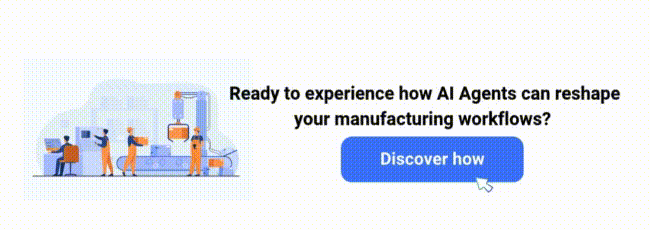The manufacturing industry is undergoing a significant transformation where there are digital technologies like AI, sensors, and automation reinventing the workflow processes. Moreover, with new levels of data-driven insights drawn for predicting risks, advanced technologies for enhancing quality, supply chain optimization, etc. pave the way for improved operational efficiency. AI Agents in manufacturing is a revolutionary advancement where these intelligent assistants go beyond prediction and recommendation.
Let’s imagine a situation: The assembly line is running at full speed. Machines hum, workers move with precision and then everything screeches to a halt. Why? The last roll of aluminum ran out, and the reorder never happened. What should’ve been a routine stock check now snowballs into missed deadlines, express shipping costs, and frustrated clients. This is exactly the kind of problem AI agents for manufacturing are built to prevent.
In this blog, we explore in-depth how AI agents in manufacturing processes transform re-ordering, increase production efficiency, improve supply chain optimization, and enhance quality.
According to a recent statistics manufacturing downtime costs U.S. $50B annually, impacting efficiency and revenue (source). A single delay would result in loss of revenue, unhappy clients, and loss of credibility. And one of the most common reasons is the loss of downtime. This is most often due to downtime from raw material shortages.
Traditional reordering systems depend on humans to monitor stock or on rigid thresholds that react too late. Therefore, the process appears to be time-consuming, making them prone to inefficiencies and delays.
In addition to that, the lack of real-time visibility makes it difficult to make informed decisions. Without continual human interaction, these AI agents in manufacturing, which range from machine learning models to AI-powered systems, can take independent actions, react in real time, and optimize production flow.
AI agents bring intelligence and proactivity into the process. Unlike traditional systems, they don’t just trigger an alert when stock is low. But they analyze real-time data, learn from it, and make decisions on the go. Therefore, manufacturing workflow automation marks the next big leap in industrial automation.
Discover how Agentic AI Solutions bring real-time intelligence and automation to manufacturing operations, minimizing downtime and maximizing efficiency.

Comparison of traditional automation and Agentic AI in manufacturing
Traditional automation often relies on fixed rules; manual intervention i.e. supervisors would manually monitor stock, check production schedules and reach out to suppliers when levels drop. However, the moment demand spikes, suppliers delay, or production speeds up, those rigid rules fall apart.
A missed reorder window or delayed supplier response can halt production, create backlogs, and trigger costly express shipments. To solve this, Agentic AI in manufacturing goes one step ahead where it is adept in not just following instructions, but thinking ahead, learning, and acting proactively. They:

How AI agents function within a manufacturing workflow
Threshold-based systems, which were traditional means of automation, would trigger an action only when it exceeds/falls below the prescribed limit. However, AI agents can easily integrate with existing ERPs and inventory management platforms. Moreover, they can tap into IoT-enabled sensors and real-time production data. Hence, this allows AI agents to act instead of waiting for stock to dip below a certain prescribed number. They can perform dynamically in the following ways:
Here is an example of a conversational user experience:

Conversational User Experience
The business benefits of Agentic AI in manufacturing:
Experience how intelligent automation accelerates project delivery and transforms business success. Learn more at A Deep Dive into AI Agents and How They Enhance Developer Workflows.
AI has already proven its value in industrial operations, with early adopters achieving up to 14% savings through AI.
The future of manufacturing workflow automation is gradually evolving into a system where humans and AI collaborate and work. The repetitive and monotonous tasks will be automated, while workers will focus on higher-value roles like monitoring, problem-solving, and continuous improvement. Moreover, by utilizing smart manufacturing solutions, Managers can take smarter decisions by value-driven insights.
AI automation isn’t limited to factories alone. Discover how we applied the same intelligence behind manufacturing optimization to accelerate payroll implementation by 50%.
Read the Success Story.
The frantic day of costly downtime is over as we see a fundamental shift from reactive crisis management to proactive intelligence. Moreover, this is just the beginning of how AI agents can embed intelligence into manufacturing workflows. For example, beyond raw material reordering, they will power predictive maintenance, adaptive quality control, and real-time supply chain optimization, interacting, adapting, and executing in ways traditional automation never could.
This is why at ThinkPalm we enable smarter workflows which would lead to less stress and greater profitability. As a result, early adopters would see a competitive advantage as the future of manufacturing is intelligent, proactive, and conversational. And it’s available today.
Future manufacturing units would be more efficient, flexible, and highly responsive. Specifically, there would be a significant reduction in costs and downtime. We aim for a system that would adapt to shifting market demands, catering to better efficiency. Therefore, manufacturers who embrace AI for reducing downtime in factories today will be the ones leading tomorrow’s smart manufacturing revolution.
